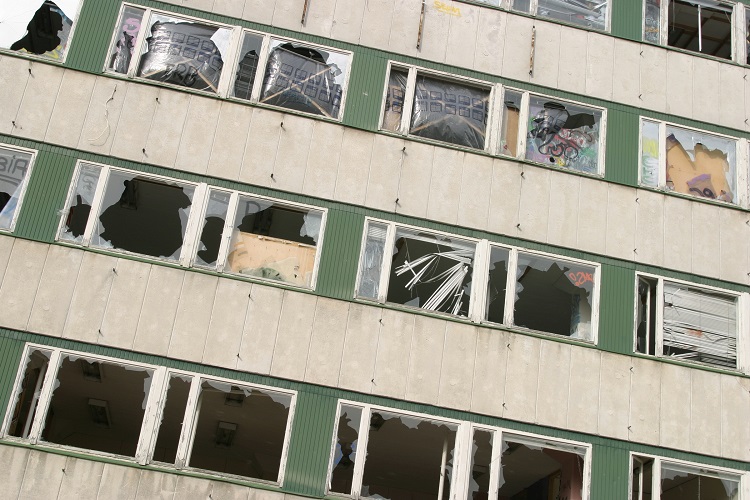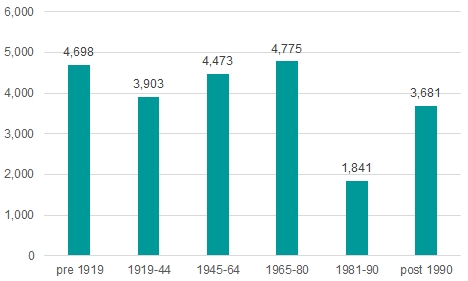Housing stock / building stock

|
| ‘Taking stock’ is a traditional idiom of the English language that derives from the practice of shopkeepers counting and valuing the number of goods in their possession. |
[edit] Housing stock
Housing stock (or dwelling stock) is a term used commonly to refer to the total number of dwellings (houses, bungalows, flats, maisonettes and bedsits) in an area, region or country that are valued as domestic or mixed for the purposes of rating.
Statistics on the housing stock are often closely related to housing supply. According to the UK’s Ministry of Housing, Communities and Local Government, there were 23.9 million dwellings in England on 31 March 2017. Of these, around 606,000 were vacant dwellings. Further information is available here.
Properties forming part of the housing stock can either be occupied or vacant. The total housing stock figure includes properties that may be temporarily uninhabitable but excludes caravans, domestic garages, domestic stores and car parking spaces.
Estimates of total housing stock are usually derived from census data from previous years using the address information for households together with information provided by householders in response to questions in the census. For years that fall between two censuses, the net number of dwellings created since the last census is added to the census figure to arrive at the current total.
Given the UK’s growing population, the housing stock tends to increase each year, even allowing for clearance and redevelopment. However, according to Shelter, successive UK governments have failed to build houses in adequate numbers, and so there is an ongoing housing crisis. In 2015, Lord Kerslake, the chair of the Commission on Affordable Housing in London said “our inability to build enough homes to meet the country’s needs is one of the biggest public policy failures over 50 years.”
For more information see: Housing shortage.
According to the English housing survey 2014 to 2015: housing stock report, the age of the housing stock in England in 2014 was (000's):
For more information see: English housing stock age and The Housing Stock of The United Kingdom.
[edit] Building stock
Building stock is a term that is used to describe the total number of buildings in a country, region, municipal area or estate. It can include dwellings, offices, factories, shops, educational establishments, agricultural buildings and so on.
The Royal Academy of Engineering report 'Engineering a low carbon built environment – The discipline of building engineering physics', published in January 2010 suggested that 80% of the buildings we will be occupying in the UK in 2050 have already been built.
[edit] Related articles on Designing Buildings Wiki
- Affordable housing.
- British post-war mass housing.
- Building.
- Domestic building.
- Dwelling.
- English housing stock age.
- Flat definition.
- Home ownership.
- Household.
- Housebuilder.
- Housing associations.
- Housing shortage.
- Housing standards review.
- Minimum space standards.
- Residential definition.
- Terraced houses and the public realm.
- The Housing Stock of The United Kingdom.
- Types of dwelling.
- What's the condition of your housing stock?
Featured articles and news
Construction Skills Mission Board launch sector drive
Newly formed government and industry collaboration set strategy for recruiting an additional 100,000 construction workers a year.
New Architects Code comes into effect in September 2025
ARB Architects Code of Conduct and Practice available with ongoing consultation regarding guidance.
Welsh Skills Body (Medr) launches ambitious plan
The new skills body brings together funding and regulation of tertiary education and research for the devolved nation.
Paul Gandy FCIOB announced as next CIOB President
Former Tilbury Douglas CEO takes helm.
UK Infrastructure: A 10 Year Strategy. In brief with reactions
With the National Infrastructure and Service Transformation Authority (NISTA).
Ebenezer Howard: inventor of the garden city. Book review.
The Grenfell Tower fire, eight years on
A time to pause and reflect as Dubai tower block fire reported just before anniversary.
Airtightness Topic Guide BSRIA TG 27/2025
Explaining the basics of airtightness, what it is, why it's important, when it's required and how it's carried out.
Construction contract awards hit lowest point of 2025
Plummeting for second consecutive month, intensifying concerns for housing and infrastructure goals.
Understanding Mental Health in the Built Environment 2025
Examining the state of mental health in construction, shedding light on levels of stress, anxiety and depression.
The benefits of engaging with insulation manufacturers
When considering ground floor constructions.
Lighting Industry endorses Blueprint for Electrification
The Lighting Industry Association fully supports the ECA Blueprint as a timely, urgent call to action.
BSRIA Sentinel Clerk of Works Training Case Study
Strengthening expertise to enhance service delivery with integrated cutting-edge industry knowledge.
Impact report from the Supply Chain Sustainability School
Free sustainability skills, training and support delivered to thousands of UK companies to help cut carbon.
The Building Safety Forum at the Installershow 2025
With speakers confirmed for 24 June as part of Building Safety Week.
The UK’s largest air pollution campaign.
Future Homes Standard, now includes solar, but what else?
Will the new standard, due to in the Autumn, go far enough in terms of performance ?
BSRIA Briefing: Cleaner Air, Better tomorrow
A look back at issues relating to inside and outside air quality, discussed during the BSRIA briefing in 2023.
Restoring Abbotsford's hothouse
Bringing the writer Walter Scott's garden to life.
Reflections on the spending review with CIAT.


























